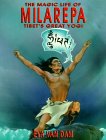

| The Magic Life of Milarepa, Tibet's Great Yogi. By Eva Van Dam. Boston: Shambhala, 1991. 78p. $16.00. ISBN 0-87773-473-9. |

|
GENRES: AUDIENCE: SYNOPSIS: The lama who taught Thopaga the hailstorm magic points out that the young man has accumulated a lot of black karma by his evil deeds, and recommends that Thopaga take instruction in Buddhist teachings. He sends the young man to Lama Rongton to learn the Great Perfection doctrine. However, with no signs of progress, Rongton sends Thopaga to Lama Marpa, the Translator (whose very name sends a thrill through Thopaga, indicating a karmic connection). Marpa and his wife Dagmema have amazing dreams that presage the arrival of a guest; Marpa spends the day plowing his field and drinking beer, waiting for his guest. When Thopaga arrives, Marpa puts him through a series of tasks (mostly building structures), each one harder than the next, each one more frustrating because Marpa keeps changing his mind about what he wants and pretending he was crazy when he ordered this or that. He also keeps promising to teach Thopaga after he completes each task, and then reneging on that promise. Dagmema tries to help the suffering young man by acting as witness to Marpa's next instructions, but Marpa sends her back to the house "where you belong." After Marpa drags Thopaga out of his temple by the hair because he has no initiation offering, Dagmema tries to cheer up the despondent young man, then snaps at her husband about his treatment of the would-be initiate. He is unmoved. Even the sight of the terrible sores on Thopaga's back do not change his attitude. In desperation, Dagmema gives Thopaga a large turquoise to use as an initiation offering, but Marpa recognizes it as her own and says "Since you yourself altogether belong to me, of course the turquoise is mine too!" He orders Thopaga to leave, but the young man stays, so Marpa literally kicks him out of the ceremony. Again Dagmema tries to help, this time getting Marpa drunk and giving Thopaga some precious relics of Naropa to offer (in Marpa's name) to another lama for instruction. But after Thopaga leaves, Marpa cries "O gurus and protectors! Please bring back my destined disciple!" The fraud is soon uncovered, partially because the new lama's instruction isn't getting results, and Thopaga and the relics are sent back to Marpa. However, Marpa won't see Thopaga, so Thopaga decides to kill himself. Unexpectedly, Marpa invites Thopaga in to receive initiation, and finally explains his tactics: "If I had been able to plunge this spiritual son of mine nine times into utter despair, he would have been completely cleansed from obstacles." But because of "Dagmema's ill-timed pity," Thopaga only suffered eight tribulations. But now Marpa is ready to impart his teachings to the discipline, who is renamed "Glorious Laughing Vajra." Years pass while Vajra meditates and is instructed. Marpa interprets dreams about his disciples. Vajra dreams a complicated dream in which he is symbolized by the pillar Milarepa and a vulture; he will be "vulture-like, endowed with the mystic truths and enduring like a rock." Marpa gives Milarepa [I guess this is when he starts to be known by this name] a text on "the science of inner heat, which allows one to live in solitude about the snowline." But Milarepa stays near the old lama at the man's request. Years later, Milarepa dreams of his mother. Marpa allows Milarepa to go visit his mother's village, and as a kind of gift manifests "the signs of a master of the esoteric" for the disciple and reveals himself as the Buddha. They will never meet again in this life. At the old village, Milarepa pretends to be a stranger and checks out his old home, where he finds his mother's bones. He gathers them up, pulverizes them, mixes them with clay, and builds miniature stupas with it. Then he goes off and lives in a cave to meditate. But when he runs out of food and goes down to beg some from nearby herdsmen, he encounters first his aunt, then his uncle. The former beats him--he's pretty feeble--but ends up giving him food after he explains that he only wants "to do as my guru told me." The latter throws stones at Milarepa and chases after him with other angry villagers, but by pretending to cast a spell, Milarepa scares them off. About to leave his cave, he is met by his aunt, who wants the little scrap of land still in his possession. He agrees to let her use it while she provides him with food, but after several months she complains that the neighbors will kill her if she continues to traffic with him. He accepts a larger offering of food and a coat and gives her the land outright. Moving to another cave, he meditates in earnest for three years. When he runs out of food he gathers nettles and lives on the soup, ultimately growing skeletal and greenish. A year later, he is accosted and abused by hunters who tried to get food from him. But he perseveres to the point where the coat rots away and he dresses in his old flour sack. Some friendly hunters offer him food, but he explains that he doesn't need it. Their tales of the green, starving hermit catch the ear of his sister, now a beggar. She is shocked by his condition and feeds him, which sets off a crisis within (food is a distraction), so he opens some sealed instructions from Marpa and immediately learns how to attain pure awareness. He gets the sensation of being able to change his shape, and he does learn to fly. His one flight attracts unwanted attention, so he goes on the move, preaching to the people who think he's a miserable wretch. He gathers many disciples who follow his practices and achieve enlightenment. One day, a rich lama tries to humiliate Milarepa by showing that the guru knows nothing about philosophy, but of course Milarepa wins. Frustrated and humiliated, the lama poisons some yoghurt and bribes his concubine to bring it to Milarepa. Fully aware of the poison, but knowing it's soon his time to die and wanting the woman to get her reward, Milarepa promises to drink it later. When the woman is paid in full by the scheming lama, Milarepa drinks the poison (though the concubine breaks down and warns him). For days, Milarepa discourses on the law of karma and the nature of reality while rainbows are seen, music is heard, and delicious odors pervade the air. When the scheming lama challenges Milarepa to transfer his sickness to him, Milarepa sends it instead to a door, which crumbles, and transfers a tiny bit to the lama, who realizes his error and begs forgiveness. When Milarepa finally "manifests the appearance of death," "the whole countryside [is] permeated with wonderful manifestation, and a feeling of ecstacy [is] experienced by everyone." Later, dakinis carry all the sacred relics of Milarepa away. EVALUATION: The narrative moves smoothly for the most part, faltering only when Milarepa stops things dead to impart a long passage of wisdom. Thankfully, there are only a few of these moments. Van Dam's full-color art is appropriately lush and vibrant, with some really stunning pages when the supernatural manifests, or when she shows the mountains. She captures a sense of place and of openness, partially by using lots of light colors (contrast the page below with the dark, claustrophic art of eXistenZ). Her faces could be a bit more mobile, but all her characters are individuals, even those in the background or in crowd scenes--that's really nice. And she's no slouch at depicting more ordinary images either, as in her lovely plowing panel.
Obviously, this book will appeal to a specialized audience. For other readers, especially would-be illustrators, it might be worth purchasing for the art. |
Return to Rational Magic Home
